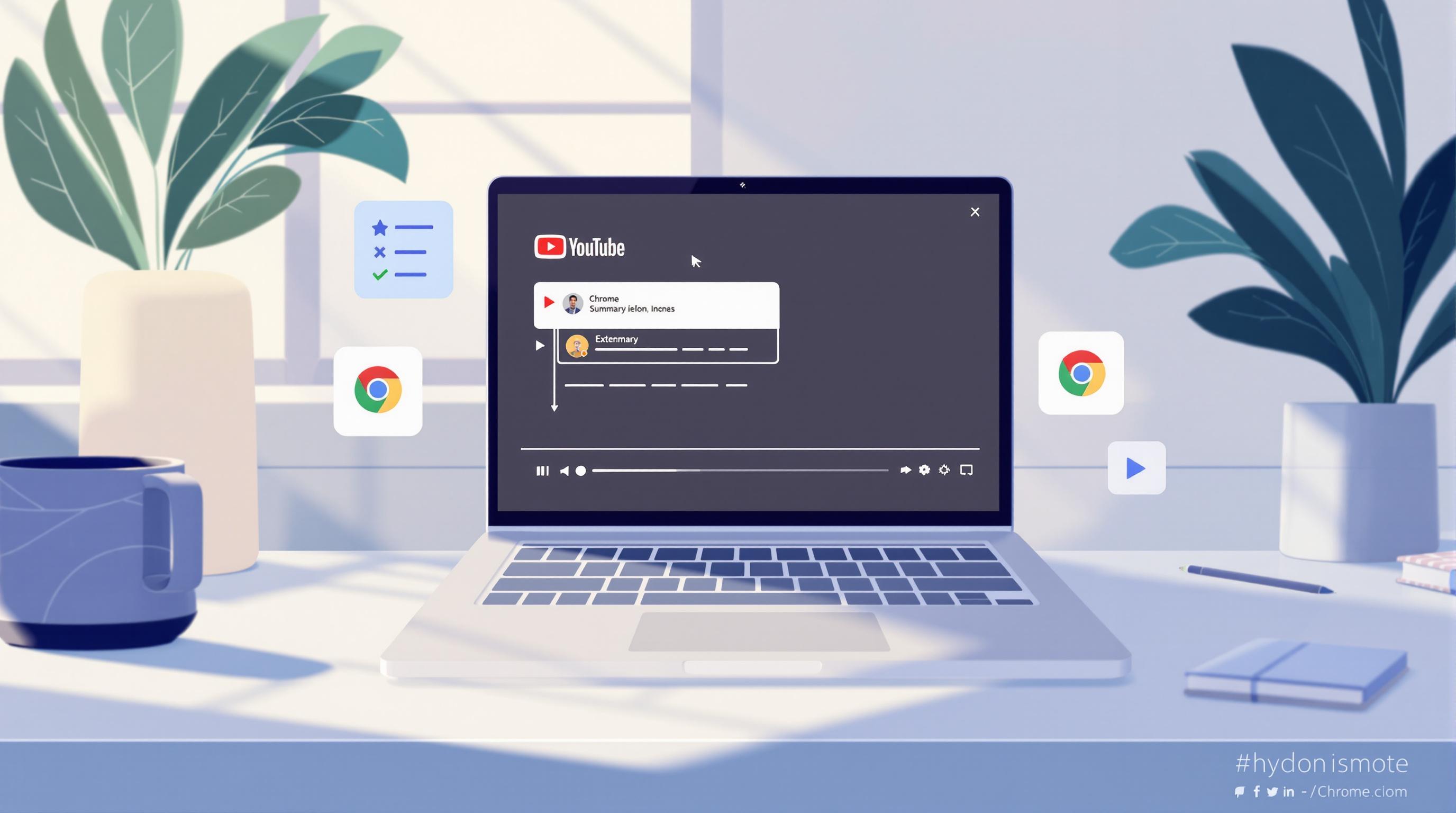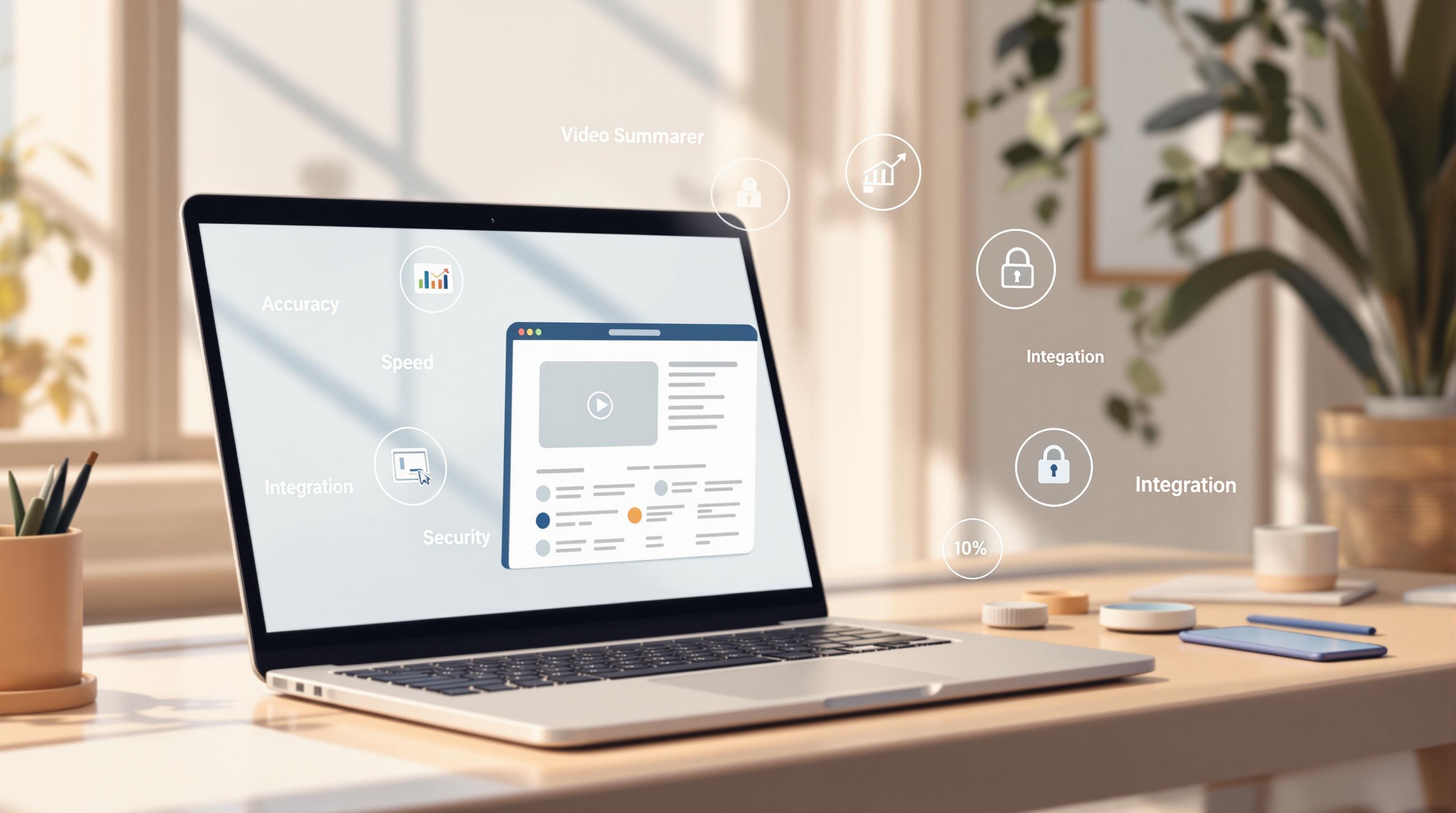Video summarization helps condense long videos into short, meaningful summaries. This is especially important for specific domains like sports, education, and surveillance, where the type of content determines the best summarization approach.
Here’s what you need to know:
- Extractive Methods: Select key frames or segments from the original video. Ideal for sports highlights, news clips, and surveillance footage.
- Abstractive Methods: Create entirely new summaries using AI, suited for storytelling in education or long-form content.
- Hybrid Approaches: Combine both methods for versatile use cases like live events or mixed media.
Quick Comparison
| Method | Best For | Key Benefit | Main Drawback |
|---|---|---|---|
| Extractive | Sports, Surveillance | Retains original content | Limited contextual understanding |
| Abstractive | Education, Long-form videos | Dynamic, narrative-driven summaries | Requires high computational power |
| Hybrid | Mixed media, Live events | Flexible and adaptable | Complex implementation |
Whether you need quick event detection or detailed storytelling, choosing the right method depends on your domain and goals. Let’s explore these techniques in detail.
AI Video Summarization - Domain-Specific Applications
1. Extractive Methods for Video Summarization
Extractive video summarization focuses on selecting and keeping the most important frames or segments from a video. These methods rely on three main algorithmic techniques to create concise and relevant summaries.
Keyframe Selection identifies important frames based on factors like objects, events, or how viewers perceive the content [2][3]. This is especially useful in sports, where it can pinpoint critical moments like goals or penalties with precision.
Shot Boundary Detection works by analyzing significant transitions in the video [6][2]. It’s particularly effective for structured content such as movies or documentaries, where detecting changes in visuals or themes helps identify key scene shifts.
Clustering-Based Approaches use machine learning to group similar frames, creating summaries that reflect patterns in the video [1][2].
Performance Across Different Domains
The effectiveness of extractive methods varies depending on the application:
| Domain | Primary Method | Effectiveness | Key Advantage |
|---|---|---|---|
| Sports | Event-based Detection | High | Highlights key actions and moments |
| Surveillance | Continuous Monitoring | Medium-High | Detects significant changes |
| Education | Clustering-based | High | Focuses on learning objectives |
| News | Shot Boundary Detection | Medium | Keeps narrative flow intact |
These methods are particularly suited for domain-specific tasks, ensuring relevance and accuracy. For example, in video surveillance, keyframe selection can quickly identify critical events, while educational platforms use clustering to create concise lecture summaries [1][2].
To improve results, hybrid techniques combine accuracy and speed, making them adaptable to various video types [2][3]. Many systems now also incorporate both visual and audio features to address limitations in contextual understanding [2][3].
While extractive methods excel at preserving original content, abstractive methods take a different route by generating entirely new summaries.
2. Abstractive Methods for Video Summarization
Abstractive video summarization creates entirely new content instead of pulling directly from existing frames. This approach offers a more dynamic way to summarize videos, especially in areas where maintaining a clear narrative is essential. Unlike extractive methods, which simply condense by selecting parts of the original content, abstractive methods reimagine the summary, making it more flexible for storytelling.
Core Technologies and Approaches
Abstractive summarization relies on several advanced technologies:
| Technology | Primary Function | Where It Excels |
|---|---|---|
| Deep Neural Networks | Generates new content | Works well with structured content |
| Reinforcement Learning | Optimizes summaries | Ideal for dynamic scenarios |
| Attention Mechanisms | Highlights key elements | Great for long-form content |
| Multi-modal Learning | Combines audio and visuals | Effective in all domains |
Domain-Specific Applications
The performance of abstractive methods varies depending on the domain. In education, these systems can distill long lectures into concise summaries while retaining essential learning points. For sports, they craft summaries that go beyond key highlights, capturing the game's overall narrative and flow.
Multi-modal Integration is a standout feature of abstractive methods. Unlike extractive approaches, these systems merge visual, audio, and textual data to create summaries that feel complete and contextually accurate [2].
Performance Considerations
While abstractive methods bring advanced capabilities to the table, they also come with challenges:
- Require significant computational resources and large datasets for effective training
- Depend heavily on domain-specific data for accurate results
- Producing detailed, context-rich summaries demands cutting-edge techniques
Implementation Strategies
For developers, frameworks like TensorFlow and PyTorch are the go-to tools for building and training abstractive models. These advanced neural networks are designed to handle complex narrative structures, making them ideal for real-time applications such as surveillance or sports analysis [2].
Abstractive methods offer a powerful way to summarize videos, but how do they compare to extractive approaches? Let’s explore their advantages and limitations side by side.
sbb-itb-26cab57
3. Overview of the Video Summarizer Directory

As video summarization becomes more specialized, the Video Summarizer Directory offers a straightforward way to find tools that meet specific needs. It’s designed to cater to the demand for customized solutions across various industries.
Algorithm Classification and Tool Selection
The directory organizes tools by their algorithm type - extractive, abstractive, or hybrid - making it easier to choose the right one for your requirements. Here's how these algorithm types are typically applied:
| Algorithm Type | Common Use Cases | Best For |
|---|---|---|
| Extractive Methods | Sports highlights, News clips | Event-based content |
| Abstractive Methods | Educational materials, Lectures | Narrative or long-form content |
| Hybrid Approaches | Live events, Mixed media | Versatile, multi-modal content |
This categorization ensures you can quickly identify tools that align with your specific goals.
Domain-Specific Applications
The directory emphasizes tools designed for particular industries. Whether you're working with sports footage, educational videos, or live broadcasts, it helps you find solutions tailored to your field. Its clear structure ensures you can focus on tools that deliver reliable results.
Tools and Features
Many tools listed in the directory combine visual, audio, and text analysis to create well-rounded summaries. This integrated approach makes them capable of handling even complex summarization tasks across diverse content types.
Performance Evaluation Framework
The directory includes a comparison framework, allowing users to assess tools based on factors like accuracy, real-time capabilities, and platform compatibility. This makes it easier to understand what each tool excels at and where it might fall short - a topic we’ll dive into further in the next section.
Advantages and Drawbacks of Each Method
Understanding the pros and cons of various video summarization techniques is key to matching the right method with specific needs. Let’s break down the main aspects of these approaches based on research and practical applications.
Extractive Methods
Extractive methods work best in situations where keeping the original content intact is a priority. For example, they shine in fields like sports analysis or surveillance, where maintaining the raw footage is crucial [2].
Abstractive Methods
Abstractive methods are better suited for scenarios where context and storytelling are essential, such as summarizing long educational videos. These methods use reinforcement learning to create summaries that capture the core message of the content [2].
Comparative Analysis
Here’s a closer look at how these methods stack up in terms of benefits, limitations, and best applications:
| Method Type | Key Benefits | Notable Drawbacks | Best Use Cases |
|---|---|---|---|
| Extractive | - Retains original quality, ideal for event detection - Requires less computational power |
- Limited understanding of context - Needs more storage |
Sports highlights, surveillance |
| Abstractive | - Produces concise, narrative-driven summaries - Saves storage space |
- High computational demands - May alter original content |
Educational videos, long-form content |
| Clustering-Based | - Effectively removes redundancy - Works well with structured content |
- Struggles with diverse or unstructured content | Surveillance, repetitive footage |
| Attention-Based | - Highlights the most relevant segments - Tailors to audience needs |
- Can miss multiple key scenes | News broadcasts, documentaries |
Performance Considerations
Clustering-based methods, for instance, achieved a 57.06% F1-score - a common metric for summarization accuracy - indicating moderate success in certain domains [5].
Implementation Insights
Supervised encoder-decoder models have proven effective for creating summaries that maintain meaning and consistency, making them a strong option for tasks requiring personalized content [3].
Choosing the right method depends on the domain, available resources, and the specific goals of the application. Extractive methods are great for real-time tasks, while abstractive methods are better for situations needing deeper understanding or storytelling. By weighing these factors, you can align your approach with your project’s unique demands.
Summary and Recommendations
After analyzing various video summarization methods tailored to specific domains, here are some targeted suggestions for different use cases and implementation scenarios.
Domain-Specific Selection Guide
For sports content, extractive methods work best. Clustering-based techniques are especially effective at identifying key moments, such as goals or major plays, while preserving the original video quality.
For educational content, abstractive methods powered by deep learning deliver better results. Models based on CNNs perform well across different datasets, creating concise summaries that retain the educational essence [4].
With these preferences in mind, let’s look at practical strategies for implementing these methods successfully.
Implementation Recommendations
| Domain | Recommended Method | Key Considerations | Resource Requirements |
|---|---|---|---|
| News & Media | Attention-Based | Real-time processing needs | Moderate computing power |
| Surveillance | Clustering-Based | Continuous monitoring needs | High storage capacity |
| Entertainment | Abstractive | Creative summary generation | Significant GPU resources |
| Education | Deep Learning | Multi-modal processing | Large training datasets |
Practical Implementation Tips
Here are some actionable tips to make implementation smoother:
- For real-time applications, focus on computational efficiency rather than perfect accuracy. Extractive methods like shot boundary detection strike a good balance between speed and effectiveness [6].
- For environments with limited resources, use the Video Summarizer Directory to find tools compatible with your system's capabilities. This platform helps match technical requirements with supported tools.
Future Considerations
To enhance summary quality, organizations should explore multi-modal learning, which combines visual and audio elements. This approach is gaining traction and shows potential for creating richer, more accurate summaries [2].


